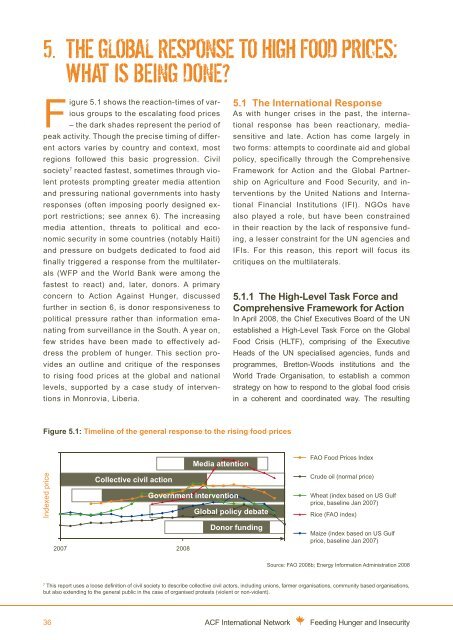5. the global response to high Food prices:5. What is being done?Figure 5.1 shows the reaction-times of variousgroups to the escalating food prices– the dark shades represent the period ofpeak activity. Though the precise timing of differentactors varies by country <strong>and</strong> context, mostregions followed this basic progression. Civilsociety 7 reacted fastest, sometimes through violentprotests prompting greater media attention<strong>and</strong> pressuring national governments into hastyresponses (often imposing poorly designed exportrestrictions; see annex 6). The increasingmedia attention, threats to political <strong>and</strong> economicsecurity in some countries (notably Haiti)<strong>and</strong> pressure on budgets dedicated to food aidfinally triggered a response from the multilaterals(WFP <strong>and</strong> the World Bank were among thefastest to react) <strong>and</strong>, later, donors. A primaryconcern to Action Against Hunger, discussedfurther in section 6, is donor responsiveness topolitical pressure rather than information emanatingfrom surveillance in the South. A year on,few strides have been made to effectively addressthe problem of <strong>hunger</strong>. This section providesan outline <strong>and</strong> critique of the responsesto rising food prices at the global <strong>and</strong> nationallevels, supported by a case study of interventionsin Monrovia, Liberia.5.1 The International ResponseAs with <strong>hunger</strong> crises in the past, the internationalresponse has been reactionary, mediasensitive<strong>and</strong> late. Action has come largely intwo forms: attempts to coordinate aid <strong>and</strong> globalpolicy, specifically through the ComprehensiveFramework for Action <strong>and</strong> the Global Partnershipon Agriculture <strong>and</strong> Food Security, <strong>and</strong> interventionsby the United Nations <strong>and</strong> InternationalFinancial Institutions (IFI). NGOs havealso played a role, but have been constrainedin their reaction by the lack of responsive funding,a lesser constraint for the UN agencies <strong>and</strong>IFIs. For this reason, this report will focus itscritiques on the multilaterals.5.1.1 The High-Level Task Force <strong>and</strong>Comprehensive Framework for ActionIn April 2008, the Chief Executives Board of the UNestablished a High-Level Task Force on the GlobalFood Crisis (HLTF), comprising of the ExecutiveHeads of the UN specialised agencies, funds <strong>and</strong>programmes, Bretton-Woods institutions <strong>and</strong> theWorld Trade Organisation, to establish a commonstrategy on how to respond to the global food crisisin a coherent <strong>and</strong> coordinated way. The resultingFigure 5.1: Timeline of the general response to the rising food pricesIndexed priceMedia attentionCollective civil actionGovernment interventionGlobal policy debateDonor funding2007 2008FAO Food Prices IndexCrude oil (normal price)Wheat (index based on US Gulfprice, baseline Jan 2007)Rice (FAO index)Maize (index based on US Gulfprice, baseline Jan 2007)Source: FAO 2008b; Energy Information Administration 20087This report uses a loose definition of civil society to describe collective civil actors, including unions, farmer organisations, community based organisations,but also extending to the general public in the case of organised protests (violent or non-violent).36ACF International Network<strong>Feeding</strong> Hunger <strong>and</strong> Insecurity
5. The global response to high food prices: what is being done?(draft) Comprehensive Framework for Action waspresented between 3rd <strong>and</strong> 5th June, 2008, at theHigh-Level Conference on Global Food Security toan audience representing 181 countries including42 Heads of State <strong>and</strong> Government, 100 high-levelministers <strong>and</strong> 60 NGOs <strong>and</strong> civil society organisations.The final Comprehensive Framework for Action(CFA) puts forth a “framework for setting outthe joint position of HLTF members on proposedactions to: 1) address the current threats <strong>and</strong> opportunitiesresulting from food price rises; 2) createpolicy changes to avoid future food crises; <strong>and</strong>3) contribute to country, regional <strong>and</strong> global food<strong>and</strong> nutritional security” (High-Level Task Force2008:vii).The strength of the CFA exists in its multi-disciplinarity(see page 5 of the CFA or annex 7), itsoutcome-focused approach <strong>and</strong> its efforts to beinclusive. The framework represents an importantattempt to provide a holistic response to high <strong>and</strong>volatile global food prices, bringing together recentdiscussions <strong>and</strong> practices from economics,health, food security, nutrition, governance, agriculture,climate change, sustainable development<strong>and</strong> other fields. The emphasis on long-term solutionsas well as immediate needs is crucial, as isthe growing support for the right to food, the centralityof technological research <strong>and</strong> development<strong>and</strong> improved global <strong>and</strong> domestic food securitymonitoring systems.While the CFA represents significant progress inan attempt to coordinate agendas in the light of the2005 Paris Declaration on Aid Effectiveness, bridgesthe traditional divide between relief <strong>and</strong> development<strong>and</strong> brings ‘<strong>hunger</strong>’ back to the forefront ofdevelopment discourse, the guidelines are largelyunimaginative – effectively proposing a review or ascale-up of existing operations. This is not in itselfa criticism of the CFA, provided that the grounds foradvocating for the scale-up of existing programmesare justified by proven success. However, there is alack of prioritisation, no clear leadership, no guaranteedfunding, no specified monitoring process <strong>and</strong>only limited participation <strong>and</strong> national ‘ownership’.PrioritisationThe CFA lists four immediate priorities: respondingto needs for food assistance <strong>and</strong> broader socialprotection, distributing inputs <strong>and</strong> other agriculturalsupport, influencing short <strong>and</strong> long-termpolicies <strong>and</strong> responding to dem<strong>and</strong>s for support.Within this statement, very little is elaborated, <strong>and</strong>suggested interventions to combat <strong>hunger</strong> in theshort-term focus largely on food aid. Advocatingfor a quick fix of the food aid system overlooksmore effective treatments of malnutrition <strong>and</strong> theneed for ready-to-use, pre-positioned resourcesbefore the <strong>hunger</strong> season.LeadershipThe CFA dem<strong>and</strong>s leadership at all levels, placingparticular emphasis on the national level.Here governments of the South are being askedto launch the assault on food <strong>insecurity</strong> <strong>and</strong> malnutritionwith support from a coordinated partnershipbetween a broad group of stakeholders,including multilaterals, national <strong>and</strong> internationalNGOs <strong>and</strong> community based organisations. Thisrecommendation comes without firm leadershipat the global level, where WFP <strong>and</strong> FAO currentlyhold, arguably, the greatest sway at the expenseof national governments. Without clear leadership,a coordinated <strong>and</strong> directed response seemsunlikely.FundingThe HLTF estimates that between US$25 <strong>and</strong>US$40 billion per year will be required to fully addressfood <strong>insecurity</strong> on a global scale – a thirddedicated to immediate assistance, <strong>and</strong> the remainderinvested to ensure long-term resilience.Half would be required for agriculture, <strong>and</strong> the otherhalf for social protection. This estimate appearsextremely conservative. In previous work, ActionAgainst Hunger estimated that between US$37billion <strong>and</strong> US$70 billion is needed to effectivelycombat seasonal <strong>hunger</strong> worldwide (explained insection 6), a figure which does not include agriculturalinterventions. Funding remains a majorconstraint to all initiatives combating malnutrition<strong>and</strong> food <strong>insecurity</strong>.ACF International Network <strong>Feeding</strong> Hunger <strong>and</strong> Insecurity 37

















